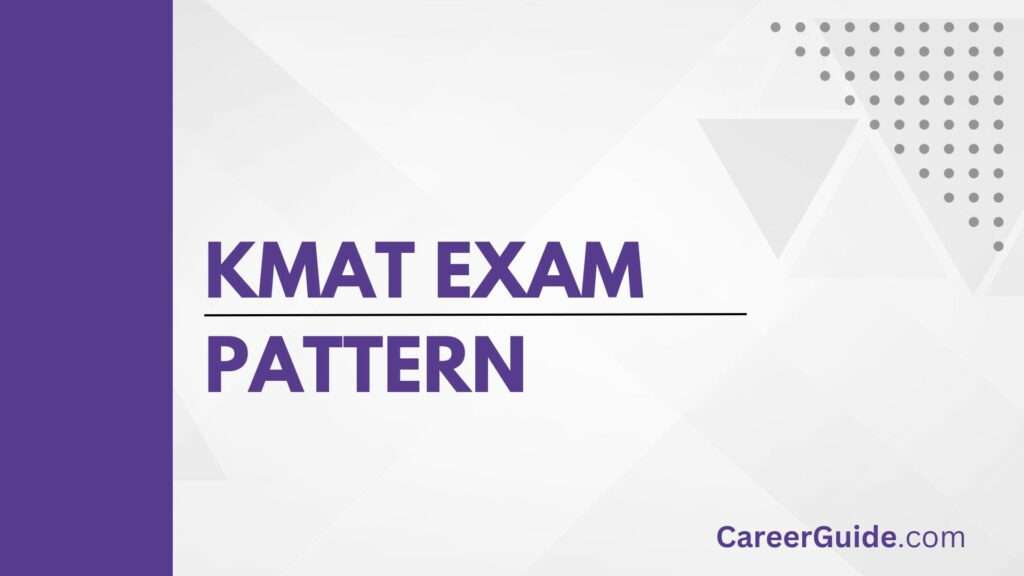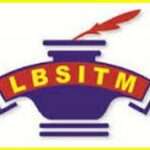KMAT Exam Pattern: The Karnataka Management Aptitude Test (KMAT) is a state-level management entrance examination conducted by the Karnataka Private Post Graduate Colleges Association (KPPGCA). KMAT is a gateway for admission to MBA, PGDM, and MCA programs offered by various B-schools and universities in the state of Karnataka.
To succeed in KMAT, it’s crucial to have a comprehensive understanding of the exam syllabus. In this extensive guide, we will explore the KMAT syllabus in detail, covering various aspects of each section, key topics, and preparation strategies.

KMAT Exam Pattern
Before delving into the syllabus, let’s briefly review the KMAT exam pattern:
- Mode of Exam: KMAT is typically a pen-and-paper-based test (offline mode).
- Sections: The exam consists of three sections: Verbal Ability and Reading Comprehension, Quantitative Ability, and Logical Reasoning.
- Total Questions: The total number of questions may vary from year to year, but it generally ranges from 120 to 180 questions.
- Marking Scheme: Each correct answer is usually awarded 1 mark.
- Negative Marking: As of my last knowledge update in September 2021, KMAT did not have negative marking. This means there is no penalty for incorrect answers.
- Time Duration: Candidates are given a specific time limit to complete the exam, typically around 2 hours.
KMAT Exam Pattern in Detail
1. Mode of Examination:
- The KMAT exam is usually conducted in pen-and-paper (offline) mode.
2. Sections in KMAT Exam:
- The KMAT exam consists of three sections: Verbal Ability and Reading Comprehension (VARC), Quantitative Ability (QA), and Logical Reasoning (LR).
3. Number of Questions:
- The total number of questions in the KMAT exam may vary from year to year. Typically, there are around 120 to 180 questions.
4. Type of Questions:
- The questions in the KMAT exam are multiple-choice questions (MCQs), where you have to choose the correct option from the given choices.
5. Duration of the Exam:
- Candidates are usually given a total of 2 hours (120 minutes) to complete the KMAT exam.
6. Marking Scheme:
- Each correct answer is awarded +1 mark.
- There is no negative marking for incorrect answers, so there is no penalty for guessing.
7. Language Medium:
- The KMAT exam is conducted in the English language.
8. Exam Timings:
- The KMAT exam is typically scheduled in the morning session.
9. Test Centers:
- KMAT exam centers are located in various cities across Karnataka. Candidates can choose a test center of their preference during the registration process.
KMAT Eligibility Criteria
The eligibility criteria for the KMAT exam are as follows:
- Educational qualification: Candidates must have a bachelor’s degree of at least 3 years duration from any recognized college or university.
- Percentage: Candidates must have secured a minimum of 50% aggregate marks in the qualifying examination (45% for SC/ST candidates).
- Final year students: Candidates who are appearing for the final year examination of their bachelor’s degree are also eligible to apply for the KMAT exam.
There is no age limit for the KMAT exam.
Additional Eligibility Criteria for MCA
In addition to the above eligibility criteria, candidates who are applying for MCA programs through KMAT must also have studied Mathematics at the 10+2 level or at the graduation level.
Reservation Policy
The following reservation policy is applicable to the KMAT exam:
- Scheduled Castes (SC): 15%
- Scheduled Tribes (ST): 7.5%
- Other Backward Classes (OBC): 27%
Note: The eligibility criteria may vary slightly from B-school to B-school. It is always advisable to check the eligibility criteria of the B-schools you are interested in before applying for the KMAT exam.
KMAT Syllabus
Now, let’s dive into the detailed syllabus for each section of the KMAT exam:
1. Verbal Ability and Reading Comprehension:
This section evaluates your language skills, including your ability to understand and analyze written material effectively. Key topics in this section include:
Reading Comprehension: You’ll encounter passages on various topics and be asked questions that test your understanding of the passage, including its main idea, supporting details, and inferences.
Vocabulary: Questions related to synonyms, antonyms, analogies, and word meanings are common.
Grammar: This includes questions on sentence correction, spotting errors, sentence completion, and other grammar-related topics.
Jumbled Sentences: You may be required to arrange a set of jumbled sentences to form a coherent paragraph or sequence.
Sentence Rearrangement: Similar to jumbled sentences, this involves rearranging sentences to create a meaningful passage.
Para Jumbles: These questions require you to arrange a set of sentences to form a coherent paragraph.
Quantitative Ability
The Quantitative Ability section assesses your mathematical skills and ability to solve numerical problems. Key topics in this section include:
Arithmetic: This includes topics like percentages, ratios and proportions, profit and loss, time and work, time and distance, averages, and simple and compound interest.
Algebra: Algebraic topics such as equations, inequalities, functions, and quadratic equations are tested.
Geometry: Geometry questions may involve concepts related to lines, angles, triangles, circles, polygons, and mensuration.
Trigonometry: Basic trigonometric concepts and identities may be included in the syllabus.
Data Interpretation: Questions in this category require you to analyze and interpret data presented in various forms, including tables, graphs, charts, and diagrams.
Number System: Questions related to properties of numbers, divisibility rules, and remainders may be included.
Probability and Statistics: Basic concepts of probability and statistics, such as mean, median, mode, and standard deviation, may be tested.
Logical Reasoning
The Logical Reasoning section evaluates your ability to think logically, analyze information, and make deductions. It assesses your problem-solving skills and your ability to draw conclusions based on given information. Key topics in this section include:
Puzzles: Various types of puzzles, such as seating arrangement puzzles, arrangement-based puzzles, and grid-based puzzles, are commonly featured in this section. These require logical thinking and the ability to make connections.
Blood Relations: Questions related to familial relationships, often involving complex family trees, are asked to assess your ability to deduce relationships.
Coding-Decoding: These questions involve coding and decoding words or phrases using specific patterns or rules.
Series: This includes number series, letter series, and mixed series questions that require identifying patterns and predicting the next item in the series.
Syllogism: Syllogism questions test your ability to draw logical conclusions from given statements using Venn diagrams or other logical methods.
Direction Sense: Questions related to directions, distances, and movement of objects or individuals.
Assumptions and Conclusions: You’ll be asked to identify assumptions underlying an argument and draw logical conclusions based on given information.
Data Sufficiency: These questions assess your ability to determine whether the given data is sufficient to answer a specific question.
Preparation Tips for KMAT
Now that you’re familiar with the KMAT syllabus, here are some tips to help you prepare effectively:
Understand the Syllabus: Start by thoroughly understanding the syllabus and the topics covered in each section.
Create a Study Plan: Develop a study plan that covers all sections of the syllabus. Allocate more time to areas where you need improvement.
Practice Regularly: Regular practice is the key to success. Solve a variety of questions from different topics to enhance your problem-solving abilities.
Mock Tests: Take full-length mock tests regularly to simulate the actual exam environment. Analyze your performance in these tests to identify areas that need improvement.
Focus on Weak Areas: Identify your weak areas and work on improving them. Whether it’s mathematics, reasoning, or language skills, targeted practice can make a significant difference.
Speed and Accuracy: KMAT demands both speed and accuracy. Strive to strike a balance between solving questions quickly and ensuring they are correct.
Reading Habit: Develop a habit of reading newspapers, magazines, and business articles to improve your reading comprehension skills.
Stay Updated: Keep up with current affairs and general knowledge as they are often tested in reading comprehension passages.
Stay Calm: On the day of the exam, stay calm and composed. Avoid last-minute cramming and focus on what you’ve learned during your preparation.
No Negative Marking Advantage: Remember that as of my last knowledge update in September 2021, KMAT did not have negative marking. So, attempt all questions, even if you are unsure about some.
KMAT Exam Day Tips
On the day of the KMAT exam, follow these tips to perform your best:
Arrive Early: Reach the exam center well before the reporting time to avoid any last-minute stress.
Admit Card: Carry your KMAT admit card and a valid photo ID (such as Aadhar card, passport, or driver’s license).
Stationery: Bring necessary stationery items like pens, pencils, and an eraser.
Read Instructions: Carefully read the instructions provided in the question paper and follow them.
Stay Calm: Maintain composure and don’t panic if you encounter difficult questions. Focus on the ones you can answer confidently.
Review Your Answers: If time permits, review your answers before submitting the paper.
entile.
KMAT Results and Scorecard
The KMAT results are usually announced within 2-3 weeks of the exam. The results are published online on the KSPITTC website.
To check your KMAT results, you will need to enter your roll number and date of birth. Once you have entered your details, your KMAT scorecard will be displayed on the screen.
The KMAT scorecard will contain the following information:
- Your name
- Your roll number
- Your date of birth
- Your overall score
- Your sectional scores
- Your percentile rank
You can download and print your KMAT scorecard for future reference.
KMAT Scorecard Validity
The KMAT scorecard is valid for one year from the date of the exam.
Using Your KMAT Scorecard
Your KMAT scorecard can be used to apply for MBA and PGDM programs in over 100 B-schools in Kerala. Most B-schools will consider your KMAT score, your academic record, and your work experience (if any) when making admission decisions.
Here are some tips for using your KMAT scorecard:
- Research the B-schools you are interested in. Make sure you understand the admission criteria of each B-school before you apply.
- Apply to multiple B-schools. This will increase your chances of getting accepted into a good B-school.
- Prepare for your interviews. Many B-schools will conduct interviews for shortlisted candidates. Be prepared to answer questions about your academic background, your work experience, and your career goals.
I hope this information is helpful. Please let me know if you have any other questions.
KMAT Admission Process
The KMAT affirmation prepare shifts from B-school to B-school. Be that as it may, most B-schools will consider your KMAT score, your scholarly record, and your work encounter (in case any) when making confirmation choices.
Here could be a common diagram of the KMAT affirmation process:
Apply to the B-schools you’re inquisitive about. Most B-schools acknowledge online applications.
Yield your KMAT scorecard and other required archives. The desired records may change from B-school to B-school, but they may incorporate your transcripts, letters of suggestion, and a statement of reason.
Shortlisted candidates will be called for an meet. The meet is an opportunity for the B-school to memorize more around you and your inspiration for seeking after an MBA or PGDM degree.
After the meet, the B-school will release a last justify list. The justify list will be based on your KMAT score, your scholarly record, your work involvement, and your execution within the meet.
Chosen candidates will be advertised affirmation to the B-school.
Here are some tips for the KMAT confirmation prepare:
Begin early. The KMAT confirmation handle can be time-consuming, so it is critical to begin early.
Investigate the B-schools you’re inquisitive about. Make beyond any doubt you get it the affirmation criteria, the expenses, and the job placement record of each B-school.
Plan for your interviews. Be arranged to reply questions almost your scholastic foundation, your work involvement, and your career objectives.
Take after up with the B-schools you’ve got connected to. After you’ve got submitted your application, take after up with the B-schools to check the status of your application and to reply any questions they may have.
I trust this data is supportive. If it’s not too much trouble let me know in case you have got any other questions.
KMAT 2023 Syllabus Highlights
| Particulars | Details |
|---|---|
| KMAT 2022 Exam Date | September 2023 (tentative) |
| Exam Mode | Internet-Based Test (IBT) |
| Exam Duration | 2 hours |
| Total No. of Questions | 120 |
| Type of Questions | Multiple Choice Questions (MCQs) |
| Examination Sections for CMAT 2022 |
|
| KMAT 2022 Marking Scheme | (+) 1 Mark for every correct answer |
| Negative Marking | No |
| TITA Questions | No |
FAQs
A: There are three sections in the KMAT exam:
- Quantitative Aptitude
- Verbal Ability
- Logical Reasoning
A: There are 60 questions in each section of the KMAT exam.
A: The total duration of the KMAT exam is 3 hours.
A: Each question in the KMAT exam carries 4 marks. There is no negative marking for incorrect answers.
A: There is no sectional cut-off in the KMAT exam. However, candidates must score a minimum of 30% in each section to be eligible for the final merit list.










